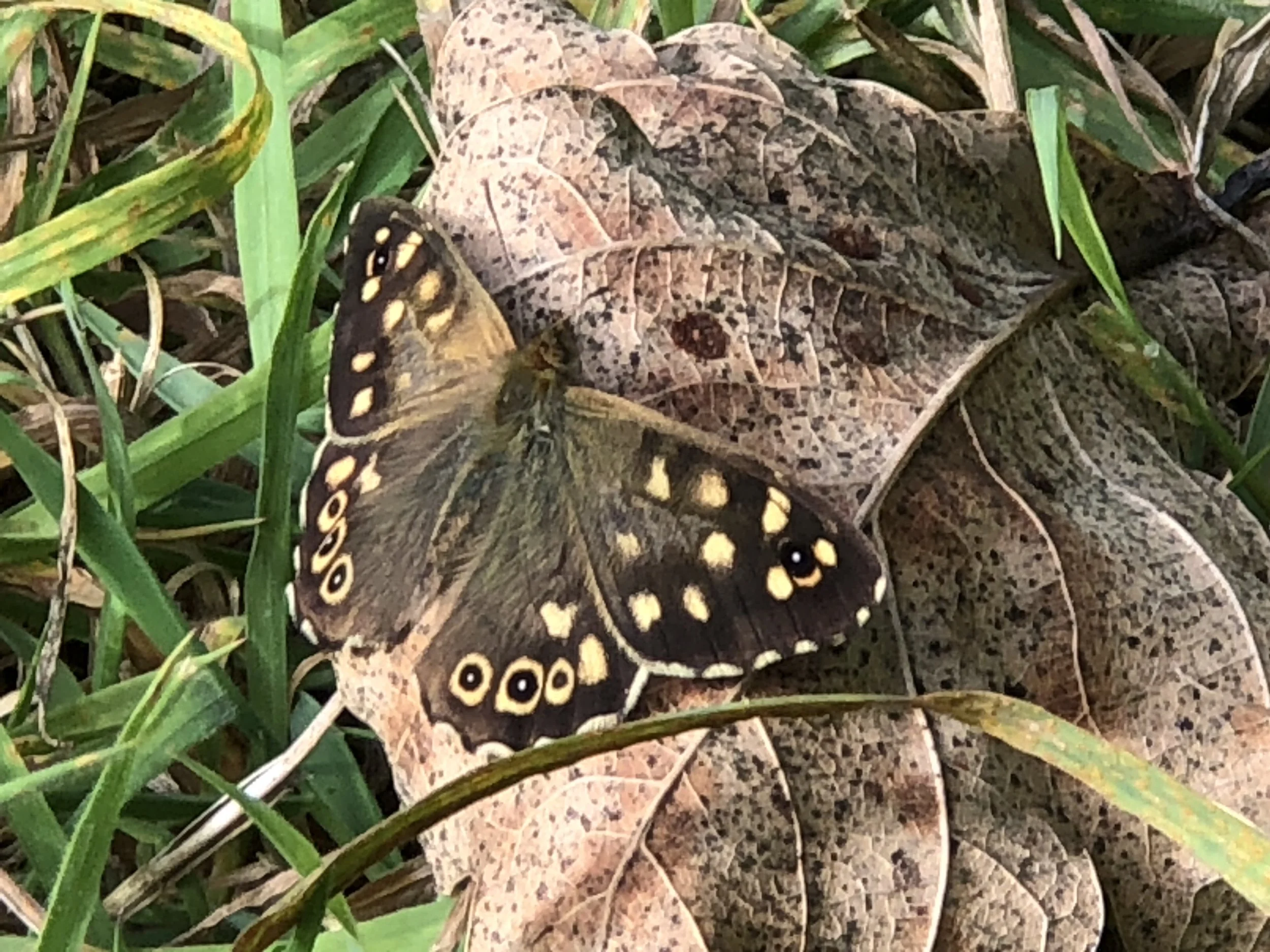There are very few videos to see this month, however a reminder that to see whatever there are, you have to access the Blog through the website: www.liddells.co.uk
What’s That Bird?
What is making the high pitched ‘tzee’ sound in the Scrub?
A postscript to August. Clare shared the photo of the Common Blue butterfly she had seen by Pond Maggiore at the end of the month with Tim. His response was, ‘Your fine photo shows pale blue spots on the outer edge of the wings between the veins. My literature does not describe this, it must be a Liddells subspecies.’ Here it is again so you can see the spots which Tim noticed. Polyommatus icarus Liddellus maybe?
8th - 9th September
Clare was amused to find a spider had made its way into her hair as she worked. The creature is a Crowned Orbweaver, commonly called a Garden Spider, although Clare prefers to think she was being awarded a crown for her work. It is probably more at home on the stone than in Clare’s hair.
John and Clare went to Edinburgh to see the Andy Goldsworthy retrospective at the Scottish National Gallery. Among all the wondrous sights, Clare enjoyed Goldsworth’s creative way with Foxglove flowers. An artistic challenge for Liddells maybe?
While Clare busied herself persuading as many of the local residents as possible to vote for the town cinema in the first ever Cinema of the Year awards, John worked steadily on with routine maintenance, finishing the new fencing round the Shepherd’s Hut (now properly sheep proof), bringing logs up from felling and working on the new gate on the Hayfield. The wildlife seemed to be on ‘routine maintenance’ too with nothing of particular interest on the trail cameras.
21st September
The voting closed and Clare hot-footed it up to Liddells to celebrate. She noticed that along with many fruiting plants, the Hawthorns and Elderberries were heavily laden. A few Branched Burrweed plants have reappeared in Pond Maggiore. They offer good habitat for emerging damsel- and dragonfly nymphs, however need thinning every few years. The pond needs some clearing as the rush is taking over. Time for Clare to don her waders. Autumn fungi has begun to appear, presenting Clare with her annual identification challenge. She is not planning to eat any of them although remembers being told that all mushrooms are edible. Some just once.
Branched burrweed
Fly agaric - the easiest to identify
Clare was amused to notice another pellet, probably from a pigeon’s crop, on the new gate on the Hayfield. Recent rain had caused the grain to sprout.
Tim sent photos of the sunset.
22nd September
Clare and John added a breasting wire outside the boundary wall that the cattle have knocked down recently. They are hoping this prevents further damage. While John hammered in posts, Clare collected up rubble from the wall repair and added it to the path coming down through the Scrub to help level the path horizontally. John had brought up spare rubble from some garden work at home, so Clare added that too. It should making coming down on the quad bike safer.
The wire doesn’t show up well on a photo so here is the start of it.
Clare then decided that carting rubble was insufficient work for the day so set about digging out the Roadside Pond before there was more rain. She was pleased with the result and very muddy. Her reward came in the form of four Small Coppers on the Mint beside Pond Maggiore (two proved to be camera shy), a Southern Hawker (frustratingly never still but caught fleetingly in a video) and another Common Blue, although this one doesn’t have the spots that Tim noticed on the August butterfly.
While she was walking around, Clare decided to note all the plants still in flower. She listed Red Clover, Purple Loosestrife, Yarrow, Buttercup, Dandelion, Mint, Common Catsear, Rosebay Willowherb, Michaelmas Daisy, Tormentil, Eyebright, Creeping Thistle, Mugwort.
23rd - 30th September
Some videos to end the month. A hare spent 12 minutes grooming in the Pit Wood. One of the videos is included just to use the caption ‘Washing your hare’.
Another clip showing a bird intent on attacking the camera - Clare decided it was trying to intrude into proceedings being held in camera.
One of the kids shows how its coat is still very spotty; a doe is seen in close up showing what beautiful creatures deer are; a doe followed by a kid squeaking show how they are both losing their summer coats; and in the cat versus squirrel battle, the squirrel seems to be the victor.
John has completed the fastenings on the new gate ready for the sheep. He discovered the apples in the Orchard had ripened. This is the first fruit from the earliest fruit tree planting several years ago.
And finally - John came home delighted to have finished the mowing for the year and even more delighted to have backed the flail mower into the storage container seamlessly on the first try! Sadly there is no photographic record of this huge achievement.
The last of the summer flowers - Rosebay Willowherb
Fruit, if not exactly fruitful
What’s that Bird? - Tree Creeper



















